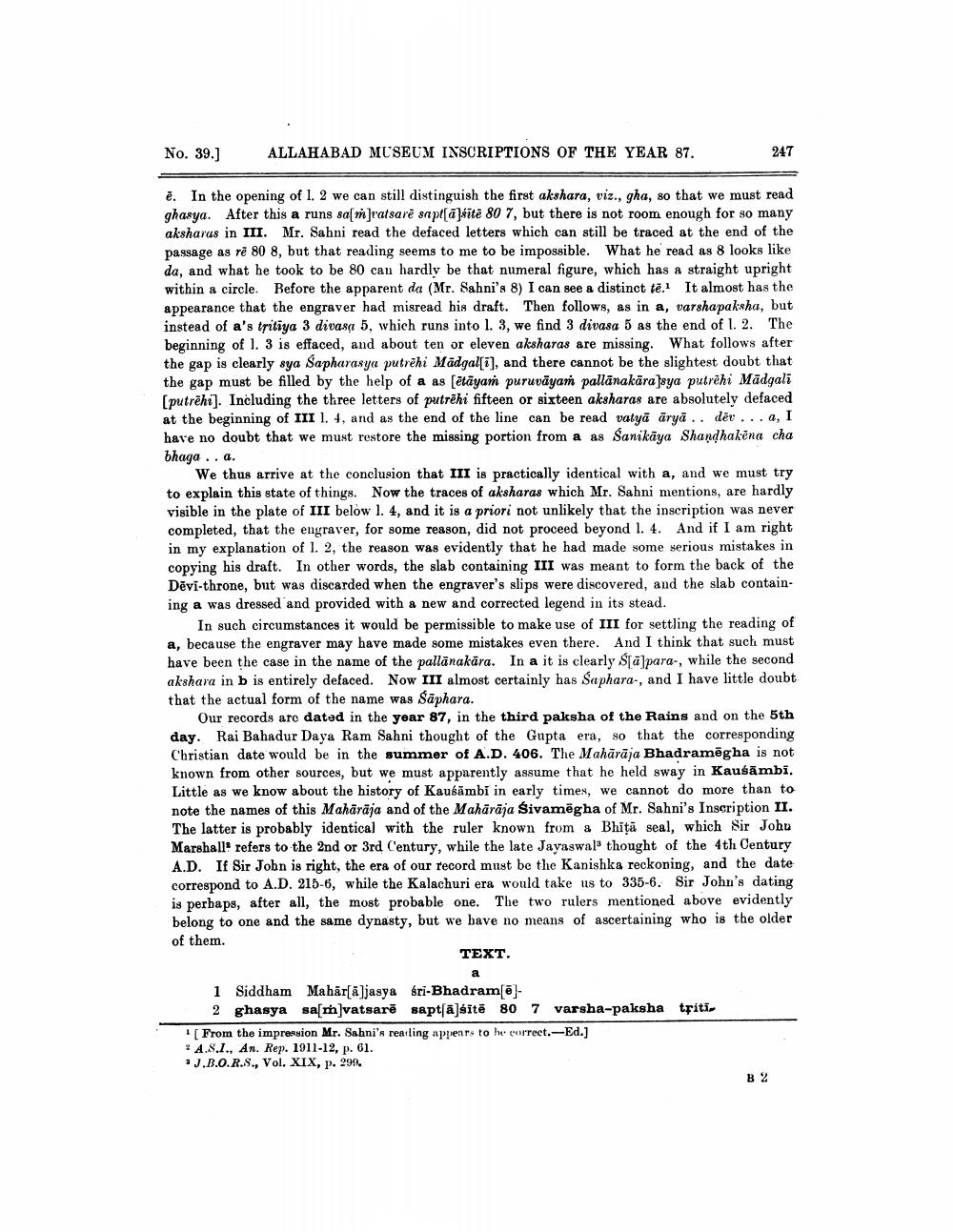________________
No. 39.]
ALLAHABAD MUSEUM INSCRIPTIONS OF THE YEAR 87.
247
e. In the opening of l. 2 we can still distinguish the first akshara, viz., gha, so that we must read ghasya. After this a runs sa[Jratsarē sapt[a]sītē 80 7, but there is not room enough for so many aksharus in III. Mr. Sahni read the defaced letters which can still be traced at the end of the passage as rē 80 8, but that reading seems to me to be impossible. What he read as 8 looks like da, and what he took to be 80 can hardly be that numeral figure, which has a straight upright within a circle. Before the apparent da (Mr. Sahni's 8) I can see a distinct te. It almost has the appearance that the engraver had misread his draft. Then follows, as in a, varshapaksha, but instead of a's tritiya 3 divase 5, which runs into 1.3, we find 3 divasa 5 as the end of l. 2. The beginning of l. 3 is effaced, and about ten or eleven aksharas are missing. What follows after the gap is clearly sya Sapharasya putrēhi Mādgal[i], and there cannot be the slightest doubt that the gap must be filled by the help of a as [ētāyam puruvayam pallānakära sya putrēhi Mădgali (putrēhi). Including the three letters of putrēhi fifteen or sixteen aksharas are absolutely defaced at the beginning of III 1. 4, and as the end of the line can be read vatyā ārya .. der... a, I have no doubt that we must restore the missing portion from a as Sanikāya Shandhakēna cha bhaga.. a.
We thus arrive at the conclusion that III is practically identical with a, and we must try to explain this state of things. Now the traces of aksharas which Mr. Sahni mentions, are hardly visible in the plate of III below 1. 4, and it is a priori not unlikely that the inscription was never completed, that the engraver, for some reason, did not proceed beyond 1. 4. And if I am right in my explanation of l. 2, the reason was evidently that he had made some serious mistakes in copying his draft. In other words, the slab containing III was meant to form the back of the Dēvi-throne, but was discarded when the engraver's slips were discovered, and the slab containing a was dressed and provided with a new and corrected legend in its stead.
In such circumstances it would be permissible to make use of III for settling the reading of a, because the engraver may have made some mistakes even there. And I think that such must have been the case in the name of the pallānakāra. In a it is clearly Śpā]para-, while the second akshara in b is entirely defaced. Now III almost certainly has Saphara-, and I have little doubt that the actual form of the name was Šāphara.
Our records are dated in the year 87, in the third paksha of the Rains and on the 5th day. Rai Bahadur Daya Ram Sahni thought of the Gupta era, so that the corresponding Christian date would be in the summer of A.D. 406. The Mahārāja Bhadramēgha is not known from other sources, but we must apparently assume that he held sway in Kaušāmbi. Little as we know about the history of Kausāmbi in early times, we cannot do more than to note the names of this Mahārāja and of the Mahārāja Śivamēgha of Mr. Sahni's Inscription II. The latter is probably identical with the ruler known from & Bhiţă seal, which Sir Johu Marshall refers to the 2nd or 3rd Century, while the late Jayaswal thought of the 4th Century A.D. If Sir John is right, the era of our record must be the Kanishka reckoning, and the date correspond to A.D. 215-6, while the Kalachuri era would take us to 335-6. Sir John's dating is perbaps, after all, the most probable one. The two rulers mentioned above evidently belong to one and the same dynasty, but we have no means of ascertaining who is the older of them.
TEXT.
1 Siddham Mahār[a]jasya sri-Bhadram[@]
2 ghasya sa[m]vatsarē saptsā]šitē 807 varsha-paksha tfiti. [ From the impression Mr. Sahni's reailing appears to be correct.-Ed.)
A.S.., An. Rep. 1911-12, p. 61. .J.B.O.R.S., Vol. XIX, p. 299.
B2




